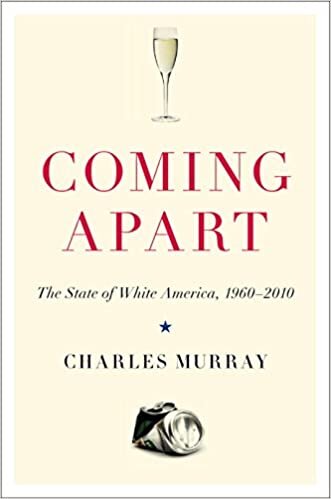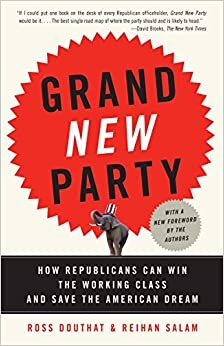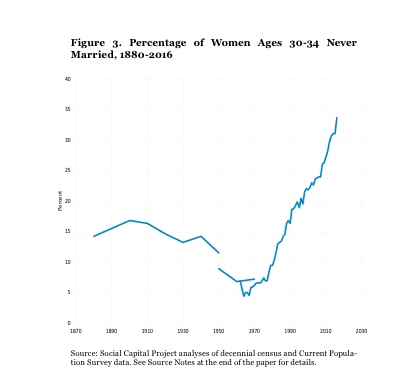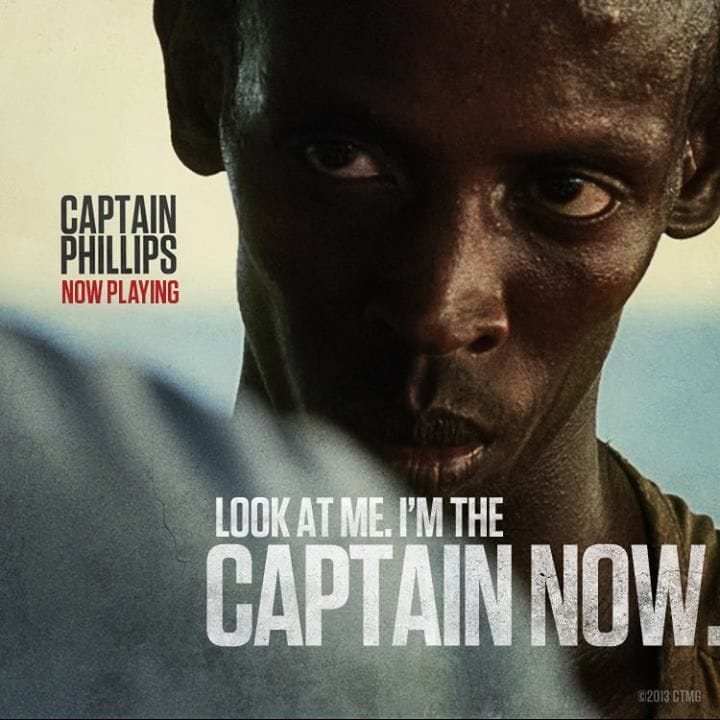The Long View: Grand New Party
John J. Reilly’s review of Ross Douthat and Reihan Salam’s Grand New Party [Amazon link] encapsulates much of his political thinking, and should be regarded as one of his key essay’s on American politics.
For example, John noted that the family structure of the 1950s was historically unusual, and cannot reliably be used as a benchmark because it represented the pinnacle of what the state could achieve at its peak of consolidation and mobilization, the end of a period John called the Long Lifetime [or sometimes the Great Lifetime or the Decisive Lifetime].
Never before, perhaps never before anywhere, had so many people lived in family units that corresponded to the cultural ideal. That degree of fidelity to theory had been created by the force of public policy, and was likely to regress to a state closer to the historical norm when the force was relaxed.

John J. Reilly also tossed out as an aside something that Charles Murray would write a whole book about:
There is a variety of reasons why American turned away from the New Deal structure, but the predicate for the change was that many of them could. Financially secure persons do not need stable family structures in the way that working class people do (although, paradoxically, the higher up the social scale you go, the more stable families become).
John never had the quantitative chops that Murray does, but his insight was fantastic.
There is as much to gain from reading this now as there was in 2008. This, for example, hasn’t changed a bit:
Conservative government, in the sense of government that worked, turned out to be expensive. That improved policing and welfare-to-work programs were more than paid for by the higher tax revenues generated by newly flourishing states and cities was even more intolerable to a certain kind of conservative.
Or this:
The situation of the working class in the early 21st century was this: It was not being immiserated; one of the things that prevented the Democrats from reestablishing hegemony was the misapprehension that the working class was become radically poorer, and so in need of precisely the kind of Great Society programs that were most certain to annoy it. It was, however, stressed and immobilized in the class structure. It was in competition with all the world’s labor and not invariably maintaining its position. The collapse of family structure (again, this become more prevalent the farther you go down the social scale) made it harder to gather the intergenerational support that is need to boost a family through higher education into professional life. Higher education itself was becoming a closed corporation, especially at the better universities. Alumni gave their children the sort of upbringing that ensured they would be qualified (and willing) to spend a large fraction of young adulthood in the great credentialing institutions that all but guaranteed a place in the mass upper-middle class.
John J. Reilly at his best was a prophet of our current age. My task is to ensure that he is not forgotten.

Grand New Party:
How the Republicans Can Win the Working Class and save the American Dream
By Ross Douthat and Reihan Salam
Doubleday, 2008
244 Pages, US$23.95
ISBN 978-0-385-51943-4
Ross Douthat and Reihan Salam have perhaps already reached the stage among people who follow applied political science where they need no introduction, which doesn’t mean they don’t get one: Douhat /Dow-thut/ is now a senior editor at The Atlantic, for which Salam is an associate editor and also a Fellow of the New America Foundation; readers may have encountered them at the blog, The American Scene. For the purposes of this book, however, the important thing about them is that they are the coauthors of an influential article in the November 14 issue of The Weekly Standard, “The Party of Sam’s Club,” which was subtitled “Isn't it time the Republicans did something for their voters?” “Their voters” were working-class people, who were rather imprecisely defined as non-destitute persons, principally white people, who did not work in an academically credentialed profession, and who routinely shopped at discount retail outlets like the Walmart- subsidiary Sam’s Club. They constitute a plurality of the electorate; their allegiance is necessary to any political party that is serious about creating a political realignment in the United States.
The elusive realignment is the underlying theme of the book. All political factions were well aware by 1970 that the New Deal political coalition had broken down, and projects immediately were launched to form a new one of comparable scope and hegemonic power. They have continued to appear on-and-off to this day. (Actually, on this shelf of books, Grand New Party might be the right-hand bookend for Michael Lind's left-hand The Next American Nation, published in 1995.) The remarkable thing about this debate is not so much its content as that it has gone on so long. A fairly stable political order ended almost 40 years ago; it ought, in the normal course of events, to have been replaced by another popular order within a few years. That has almost happened several times, but always the new realignment dissolved. Why is this happening?
For an example of a durable political configuration, the authors turn to the New Deal itself. That settlement was immensely popular for a very long time because its goals were essentially conservative, no matter that the means were often semi-socialist. Family independence was what the New Deal system tried to conserve. This effort had two faces. One was a set of policies aimed at the widespread distribution of property and entitlements to enable families to live in homes they owned, and with a large measure of insulation against the economic cycle and even technological innovation. The other face was a set of policies to ensure that the people living in these homes would raise children in a predictable environment and have no difficulty educating them. This latter set of policies was informed by an ideology called "maternalism" (in the 1950s, we may note, it was already being parodied as "momism"). Remarkably, it was a version of Progressive Era feminism come to power. According to this school of thought, wage labor for women of childbearing age was necessarily a form of unfair exploitation, as was any step toward sexual libertinism. (The Republican Party of the 1920s, the authors note, was in favor of the former if not of the latter.) Maternalism promoted "the family wage," under which only men were expected to work outside the home. It was fairly generous to intact families that fell on hard times, but set its face against subsidies for illegitimate children, or indeed for single people who did not get with the program.
As the authors note, this configuration occurred during the long immigration holiday of the middle 20-century, when assimilation ensured that every year the country became less diverse. This is an important point, because one of the less well-publicized discoveries of social science is that diversity decreases social trust. In a diverse environment, people are not only more likely to distrust people who are different from themselves; they are less likely to trust people whom they regard as similar. The flip side is that electorates are usually more generous about taxing themselves for social spending when they feel themselves to be in a state of solidarity with the recipients. This is, of course, most perfectly the case when they are the recipients.
And that was the difference between the New Deal and the Great Society. New Deal programs had wide support because, even if they were sometimes economically suboptimal, they were not for the indigent: they were for the middle class, which included the working class that aspired to middle-class status for the next generation. The Great Society programs of the 1960s, though actually not as unsuccessful as it is sometimes remembered (especially with regard to the well-being of the elderly) nonetheless tended to undermine solidarity rather than strengthen it. For a typical member of the working class, his taxes rose to pay subsidies to someone else, while he himself was more likely to be mugged.
The authors take care not to idealize the postwar New Deal, when prosperity seemed entwined with bureaucracy on every hand. For one thing, it was based on a moment in technological history when relatively high-paying, low-skill factory work seemed to be the fate of the bulk of the working-age population. In terms of family stability, it was also arguably too much of a good thing. Certainly it gave inadequate scope to the talents of women, who were increasingly well educated (another goal of maternalism) and less in need of insulation from the market economy than their mother and grandmothers had been. Never before, perhaps never before anywhere, had so many people lived in family units that corresponded to the cultural ideal. That degree of fidelity to theory had been created by the force of public policy, and was likely to regress to a state closer to the historical norm when the force was relaxed.
There is a variety of reasons why American turned away from the New Deal structure, but the predicate for the change was that many of them could. Financially secure persons do not need stable family structures in the way that working class people do (although, paradoxically, the higher up the social scale you go, the more stable families become). Neither, of course, do they rely on public services. For the first time in human history, there was a mass upper middle class, distinguished, again, more by its education than by its wealth. Their educations made the breakdown of monopolies and unions a genuine entrepreneurial liberation. As the 1960s and '70s progressed, this large group developed interests and projects of its own, on the Right as on the Left. What distinguished the Left, however, was the tendency to delegitimise complaints about the general coarsening of public for which it was in part responsible:
In Chain Reaction, otherwise one of the smartest left-of-center books about the working class’s rightward turn, Thomas and Mary Edsall remark that “crime became a shorthand signal, to crucial numbers of white voters, of broader issues of social disorder, tapping powerful ideas about authority, status, morality, self-control, and race” – as though it weren’t more likely that crime itself was the issue, in an era of unprecedented lawlessness, and that all those “powerful ideas” were really just “shorthand signals” themselves, for voter anxiety over the safety of homes and neighborhoods...
At least in the authors' telling, the Left did not merely lose the working class: they forcibly discarded it. The model theory is said to have been devised during the Nixon Administration by the Democratic political scientist, Fred Dutton. He argued that the traditional industrial working class was doomed by technology and in any case was incurably reactionary. The hope for the future lay in an alliance of the young, of blacks, and of the college educated. He had a point about the relative decline of the industrial workforce; however, as the authors pointed out, he overlooked the fact that "the young" often don't vote until they are 35 years old. His most interesting error, however, was a genuine historical surprise: in the 1970s, the percentage of the adult population with college degrees topped off at between a fifth and a quarter. Though there has been an uptick again in the 21st century, college shows no sign of becoming universal. Nonetheless, Dutton would have his day: the Clinton Administration was, almost, the incarnation of his scenario.
Before that could happen, however, there came the day of the Right and the neoconservatives. Much better known than Fred Dutton was Kevin Phillips, writing at about the same time as Dutton, who announced the possibility of a permanent Republican majority. This would be based on the assimilation into the Republican Party of the orphaned working class, provided the party took steps to address the working class's need for family independence and social solidarity. Richard Nixon, to his credit, saw the possibilities; even more so did Daniel Patrick Moynihan, the proto-neoconservative domestic policy advisor in the Nixon White House. In general, though, the tale of years since has been the refusal of the Republican establishment to seal the deal:
Over the forty years since, this problem – that the working class wants, and needs, more from public policy than simply to be left alone – has prevented the Republican Party from consolidating an enduring majority, despite all the right-wing intellectual victories and all the conservative electoral gains. It defeated Goldwater, it ruined Gingrich, and it crippled the domestic policy of George W. Bush. It was at the heart of a marginal conservatism’s 1964 defeat, and it lies at the heart of conservatism’s present crisis....
In the 1990s, elements in both parties had realized that, although the working class would never again be "the people," they were nonetheless necessary to any party that hoped to exercise political hegemony. The brighter lights on both sides took not wholly cosmetic measures designed to meet the populist agenda; that fiend, Bill Clinton, not only dramatically reduced welfare dependency, but balanced the budget, too. In the authors' assessment, the 1990s were a genuinely conservative decade. The problem was that the antics of the Republican establishment ensured that the conservatives would get little credit for the remarkable social improvement during those years:
It was figures like [Tommy] Thompson [of Wisconsin]—reformist Republican governors like John Engler in Michigan, reformist Republican mayors like Rudolph Giuliani in New York—who achieved the greatest conservative victories in the 1990s; it wasn’t, tellingly, the more strident government-cutters in the House of Representatives, who led their party to defeat in its battles with Bill Clinton. As a result of the labor undertaken by the GOP’s Thompson, crises that everyone agreed were intractable—urban decay, violent crime, family breakdown—seemed, from the vantage point of the millennium, to have been successfully tamed....
Conservative government, in the sense of government that worked, turned out to be expensive. That improved policing and welfare-to-work programs were more than paid for by the higher tax revenues generated by newly flourishing states and cities was even more intolerable to a certain kind of conservative.
George Bush, however, was supposed to be the other kind of conservative. Initiatives like his No Child Left Behind Education program, and the new provision for prescription drugs for seniors, may be debated on their merits, but they were the kind of measure that historically has won the allegiance of the working class. Certainly they were the kind of thing that interested it. That is more than can be said for the Republican Party’s relentless harping on lower taxes, in deficit and surplus, and with amnesiac disregard for the fact that Ronald Reagan had already lowered the federal income tax on working-class far enough to take the issue off the table. Bush shared the tax fetish, of course, but the authors conclude that he won in 2000, after a fashion, because:
...Bush returned to the animating insight of the post-Goldwater Republican Party: The right can succeed only if it champions a politics of solidarity as well as liberty.
Bush had better instincts for this sort of initiative than Richard Nixon had, or perhaps even Ronald Reagan. Unlike those two presidents, he really was not much interested in foreign policy. Had history given him the opportunity, he might have recouped the opportunities that the GOP had squandered in the 1990s. On the other hand, these were still exotic concerns in the Republican Party, and even in the Bush White House, where they were sometimes derided as “Christian Socialism.” Most of the Bush's policies long these lines were enacted after 911, but on automatic pilot. The White House and the party were no longer thinking about them. Rather, the Bush Administration trusted that it would be able to maintain its political clout by uninterrupted diplomatic and military successes. About that, the authors make this shrewd surmise:
[T]he danger to the GOP was greater than it had been during previous trips into the political wilderness. ..Bush’s failure in Iraq didn’t just negate the Republican foreign-policy advantage in the short-run, it threatened to break the GOP’s long-term reputation as the [party] of competence and strength abroad...[E]ven if the GOP finds a way to build on Bush’s successes rather than abandoning them, his failures are still likely to drag at his successors—particularly the foreign-policy legacy of the Iraq War, which will likely be an albatross for Republicans for many years to come.
Actually, the assessment of the “legacy of the Iraq War” will be one of the great surprises of the next five years, but that’s another story. Certainly it won’t save the Republican Party by itself.
The situation of the working class in the early 21st century was this: It was not being immiserated; one of the things that prevented the Democrats from reestablishing hegemony was the misapprehension that the working class was become radically poorer, and so in need of precisely the kind of Great Society programs that were most certain to annoy it. It was, however, stressed and immobilized in the class structure. It was in competition with all the world’s labor and not invariably maintaining its position. The collapse of family structure (again, this become more prevalent the farther you go down the social scale) made it harder to gather the intergenerational support that is need to boost a family through higher education into professional life. Higher education itself was becoming a closed corporation, especially at the better universities. Alumni gave their children the sort of upbringing that ensured they would be qualified (and willing) to spend a large fraction of young adulthood in the great credentialing institutions that all but guaranteed a place in the mass upper-middle class.
Meanwhile, the working class suffered a novel and dispiriting drag from below, caused by the relentless immigration of low-skill workers, legal and illegal. The authors point out that this immigration assimilates culturally about as fast as its predecessors. What it generally fails to do is assimilate economically: it is not reasonable to expect people with a high-school education or less to be able to join the middle class. The effect is not just stagnant wages for manual work among the native born; continuing high immigration ensures permanently depressed wages among immigrants.
In sum, the authors say, meritocracy and immigration threaten to freeze the social structure in amber. The Democratic solution tends toward a European model in which the state replaces the family. Republicans, in contrast, seem satisfied with a Latin American future, in the sense of a society in which the rich are permanently rich and the poor are permanently poor. This assessment may exaggerate the situation. Nonetheless, it is true that the economic expansion that has occurred during the Bush years has been remarkable, in particular in contrast with the 1990s, for the failure of wages to keep pace with increases in productivity. Republican attempts to spin the situation have not been well received:
...Republican pollster David Winston found in a survey conducted in early 2007 [that] working-class voters resent the idea that they simply don’t appreciate how great the economy really is, with low inflation, low unemployment, and relatively high growth. That’s the message that too many conservatives have been pushing, and it’s done considerable harm to the Republican brand. Though the new economy and the new sexual order both offer more freedom and more independence, they also vastly multiply the bad decisions a family can make....
The situation is not yet desperate, but the time is no longer unforeseeably distant when the politics and culture of the United States would be permanently deformed if corrective measures are not taken. The authors have some specific proposals of their own, some more serious than others, but all of them worth thinking about. A good summary of their views appears in the context of their treatment of immigration (where they have no patience with open-borders conservatism, but would be happy to entertain proposals for amnesty once the high rate of entry subsides):
[I]nstead of offering Hispanics a guest-worker plan that speaks only to their ancestral sympathies, conservatives should be offering the same opportunity agenda that they offer all Americans—health security, a family-friendly tax code, wage subsidies to help you climb out of poverty, and an educational system that lets you rise toward affluence. The ultimate goal should be a politics of solidarity, a constellation of policies that all Americans—blacks as well as whites, the poor as well as the prosperous, recent immigrants as well as natives—believe that we’re in this thing together.
Some of the authors’ ideas are almost unique in trying to address what working-class Americans actually want. For instance, the authors are keen on building more transportation infrastructure, but they mean highways, not mass transit. Most Americans drive, and the increasing congestion of the roads and of commuting times in recent years mark a serious decline in their quality of like. Among their other proposals, the authors have three novel ideas:
First, to address the family-formation issue by increasing the tax deduction for dependent children high enough to take the working-class parents of several children off the federal tax rolls, including the payroll tax. In effect, it would be paying fathers to stick around. This notion has an attractive simplicity; it may even be the case, as the authors speculate, that the system would pay for itself when the children matured and the parents reached their prime-earning years. On the other hand, one cannot help but remark that the authors themselves say that most of the tax budget of the working class was already given away by Ronald Reagan.
Second, in order to fight the development of a hereditary mandarinate, the authors propose to limit professional credentials to real credentials. Academic degrees should be granted on the passage of an exam; where the test takers study to pass the test should be their own concern. To this we may remark that systems like this are not unheard of. There may still be places in the United States where an aspiring lawyer need only present oneself to take the bar exam, without the need of a law degree. Actually, this is even something like the traditional degree-granting role of some European universities, though they require the test-takers to belong to one of the university's colleges. In any case, the authors hope that it would break the baleful link between attendance at elite universities and the domination of government and the professions by a congealing caste of families.
Well, maybe. Still, the authors themselves observe that the Scholastic Aptitude Test in the US was intended as a democratizing move. It has instead had the opposite effect. Letting aspiring degree-holders design their own educations is not necessarily a path to broader access to credentials.
Third, and most ingeniously, the authors propose the settling of America; of the lightly people Midwest and West, areas that often have lower populations than they did before the First World War. The authors are aware that the corn-based ethanol project is a political racket, but they also insist, with some reason, that other sources of biofuels really are the best answer to the end of the petroleum age. The Midwest is just the place to center a biofuels economy, and with it a new stage of American society. In the authors' characterization, America is increasingly dominated by caste-ridden cities on the coasts, where highly educated and relatively childless members of the mass upper class live with their dogs and their Spanish-speaking servants. In contrast, the center of the country could fill up with what they call "aspirational Cities," like Oklahoma City and Denver, where the working class would no longer be socially and geographically constricted, as it increasingly is now.

To this one might say: again, maybe. The problem is the peopling of the West requires people, and if immigration is to be sharply curtailed, then they will have to be made domestically. One cannot preclude the possibility of another event like the Baby Boom, but the authors never engage the demographic question in detail.
To summarize, one might say that the authors’ philosophy and their proposals are a bunch of stuff, of the sort of odds and ends that might be found scribbled on the backs of envelopes at think tanks. The same was true of the New Deal agenda, however. If anything, the thrust of Grand New Party is much better thought out. Also, unlike the most of the literature about the Coming Realignment, this book is a genial exercise. It does not define the problem by identifying an enemy and then plotting its destruction. (The authors’ “mass upper middle class” is a large group of lucky people whose happy state should be emulated, unlike the Michael Lind’s malign and doomed “Overclass.”) Altogether, the book is a sunny window on a plausible future. But could it work?
It is not impossible that the state of security and solidarity that the authors seek to revive is now anachronistic. The New Deal was the American version of the height of the mobilization that characterized the whole West during the Great Lifetime from 1860 to 1945. The age of the great wars and of the great economic upheavals, it was the time when the lives of the nation and the state merged in order to meet public emergencies that could not have been addressed in any other way. Maybe, as the generations pass from those years of highest tension, it is only to be expected that the solidarity of that time will gradually pass, too. Perhaps the transition to a society loosely defined by caste is a natural development, to be managed rather than deplored. There are worse places in the world to live than Brazil, after all. Some of the Republican (and Democratic) establishment seem comfortable with that prospect, even if the idea has never occurred to them in so many words.
More likely, however, it is still too early for a relaxation to a more traditional form of society to occur. Certainly the globe’s “Era of Contending States” still has several generations left to run. Actually, one unfortunate trait that Grand New Party shares with other Coming Realignment books is a studied indifference to America’s place in the world. Even the treatment of economical globalization is a subsidiary theme. The authors note the parallel developments in Europe, but chiefly to emphasize the American Sonderweg. In fact, though, if the 21st century is to see a return of social solidarity to America, that is likely to occur in conjunction with global events. That is what happened in the generation of the New Deal, and the world has not gotten any bigger since.
Copyright © 2008 by John J. Reilly



Comments ()